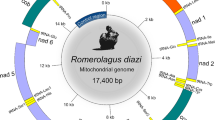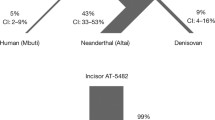Abstract
Monkey mummy bones and teeth originating from the North Saqqara Baboon Galleries (Egypt), soft tissue from a mummified baboon in a museum collection, and nineteenth/twentieth-century skin fragments from mangabeys were used for DNA extraction and PCR amplification of part of the mitochondrial 12S rRNA gene. Sequences aligning with the 12S rRNA gene were recovered but were only distantly related to contemporary monkey mitochondrial 12S rRNA sequences. However, many of these sequences were identical or closely related to human nuclear DNA sequences resembling mitochondrial 12S rRNA (isolated from a cell line depleted in mitochondria) and therefore have to be considered contamination. Subsequently in a separate study we were able to recover genuine mitochondrial 12S rRNA sequences from many extant species of nonhuman Old World primates and sequences closely resembling the human nuclear integrations. Analysis of all sequences by the neighbor-joining (NJ) method indicated that mitochondrial DNA sequences and their nuclear counterparts can be divided into two distinct clusters. One cluster contained all temporary cytoplasmic mitochondrial DNA sequences and approximately half of the monkey nuclear mitochondriallike sequences. A second cluster contained most human nuclear sequences and the other half of monkey nuclear sequences with a separate branch leading to human and gorilla mitochondrial and nuclear sequences. Sequences recovered from ancient materials were equally divided between the two clusters. These results constitute a warning for when working with ancient DNA or performing phylogenetic analysis using mitochondrial DNA as a target sequence: Nuclear counterparts of mitochondrial genes may lead to faulty interpretation of results.
Similar content being viewed by others
References
Anderson S, Bankier AT, Barrell BG, de Bruijn MHL, Coulson AR, Drouin J, Eperon IC, Nierlich DP, Roe BA, Sanger F, Schreier PH, Smith AJH, Staden R, Young IG (1981) Sequence and organization of the human mitochondrial genome. Nature 290:457–465
Boom R, Sol CJA, Salimans MMM, Jansen CL, Wertheim-van Dillen PME, van der Noordaa J (1990) Rapid and simple method for purification of nucleic acids. J Clin Microbiol 28:495–503
Cardon LR, Burge C, Clayton DA, Karlin S (1994) Pervasive CpG suppression in animal mitochondrial genomes. Proc Natl Acad Sci USA 91:3799–3803
Fukuda M, Wakasugi S, Tsuzuki T, Nomiyama H, Shimada K, Miyata T (1985) Mitochondrial DNA-like sequences in the human nuclear genome. Characterization and implications in the evolution of mitochondrial DNA. J Mol Biol 186:257–266
Gellissen G, Bradfield JY, White BN, Wyatt GR (1983) Mitochondrial DNA sequences in the nuclear genome of a locust. Nature 301: 631–634
Gray MW (1989) The evolutionary origins of organelles. Trends Genet 5:294–299
Hadler HI, Dimitrijevic B, Mahalingam R (1983) Mitochondrial DNA and nuclear DNA from normal rat liver have a common sequence. Proc Natl Acad Sci USA 80:6495–6499
Higgins DG, Sharp PM (1988) CLUSTAL: a package for performing multiple sequence alignments on a microcomputer. Gene 73:237244
Höss M, Pääbo S (1993) DNA extraction from Pleistocene bones by a silica-based purification method. Nucleic Acids Res 16:3913–3914
Jakobs BS, van den Bogert C, Dacremont G, Wanders RJA (1994) β-Oxidation of fatty acids in cultured human skin fibroblasts devoid of the capacity for oxidative phosphorylation. Biochim Biophys Acta 1211:37–43
Kamimura N, Ishii S, Liandong M, Shay JW (1989) Three separate mitochondrial DNA sequences are comigious in human genomic DNA. J Mol Biol 210:703–707
Kocher TD, Thomas WK, Meyer A, Edwards SV, Pääbo S, Villablanca FX, Wilson AC (1989) Dynamics of mitochondrial DNA evolution in animals: amplification and sequencing with conserved primers. Proc Natl Acad Sci USA 86:6196–6200
Kumar S, Tamura K, Nei M(1993) MEGA: molecular evolutionary genetics analysis, version 1.0. The Pennsylvania State University, University Park, PA
Lopez JV, Yukhi N, Masuda R, Modi W, O'Brien SJ (1994) Numt, a recent transfer and tandem amplification of mitochondrial DNA to the nuclear genome of the domestic cat. J Mol Evol 39:174–190
Marzuki S, Noer AS, Lertrit P, Thyagarajan D, Kapsa R, Utthanapol P, Byrne E (1991) Normal variants of human mitochondrial DNA and translation products: the building of a reference data base. Hum Genet 88:139–145
Nomiyama H, Fukuda M, Wakasugi S, Tsuzuki T, Shimada K (1985) Molecular structures of mitochondrial DNA-like sequences in human nuclear DNA. Nucleic Acids Res 13:1649–1658
Perizonius WRK, Attia MAM, Smith HS, Goudsmit J (1993) Monkey mummies and North Saqqara. Egyptian Archaeol 3:31–33
Smith MF, Thomas WK, Patton JL (1992) Mitochondrial DNA-like sequence in the nuclear genome of an akodontine rodent. Mol Biol Evol 9:204–215
Tamura K (1992) Estimation of the number of nucleotide substitutions when there are strong transition-transversion and G+C-content biases. Mol Biol Evol 9:678–687
Thomas RH, Schaffner W, Wilson AC, Pääbo S (1989) DNA phylogeny of the extinct marsupial wolf. Nature 340:465–467
Tsuzuki T, Nomiyama H, Setoyama C, Maeda S, Shimada K (1983a) Presence of mitochondrial-DNA-like sequences in the human nuclear DNA. Gene 25:223–229
Tsuzuki T, Nomiyama H, Setoyama C, Maeda S, Shimada K, Pestka S (1983b) The majority of cDNA clones with strong positive signals for the interferon-induction-specific sequences resemble mitochondrial ribosomal RNA genes. Biochem Biophys Res Commun 114: 670–676
Van der Kuyl AC, Dekker J, Atria MAM, Iskander N, Perizonius WRK, Goudsmit J (1994) DNA from ancient Egyptian monkey bones. Ancient DNA Newslett 2:19–21
Van der Kuyl AC, Kuiken CL, Dekker JT, Goudsmit J (1995) Phylogeny of African monkeys based upon mitochondrial 12S rRNA sequences. J Mol Evol 40:173–180
Author information
Authors and Affiliations
Additional information
Correspondence to: A.C. van der Kuyl
Rights and permissions
About this article
Cite this article
van der Kuyl, A.C., Kuiken, C.L., Dekker, J.T. et al. Nuclear counterparts of the cytoplasmic mitochondrial 12S rRNA gene: A problem of ancient DNA and molecular phylogenies. J Mol Evol 40, 652–657 (1995). https://doi.org/10.1007/BF00160513
Received:
Accepted:
Issue Date:
DOI: https://doi.org/10.1007/BF00160513




